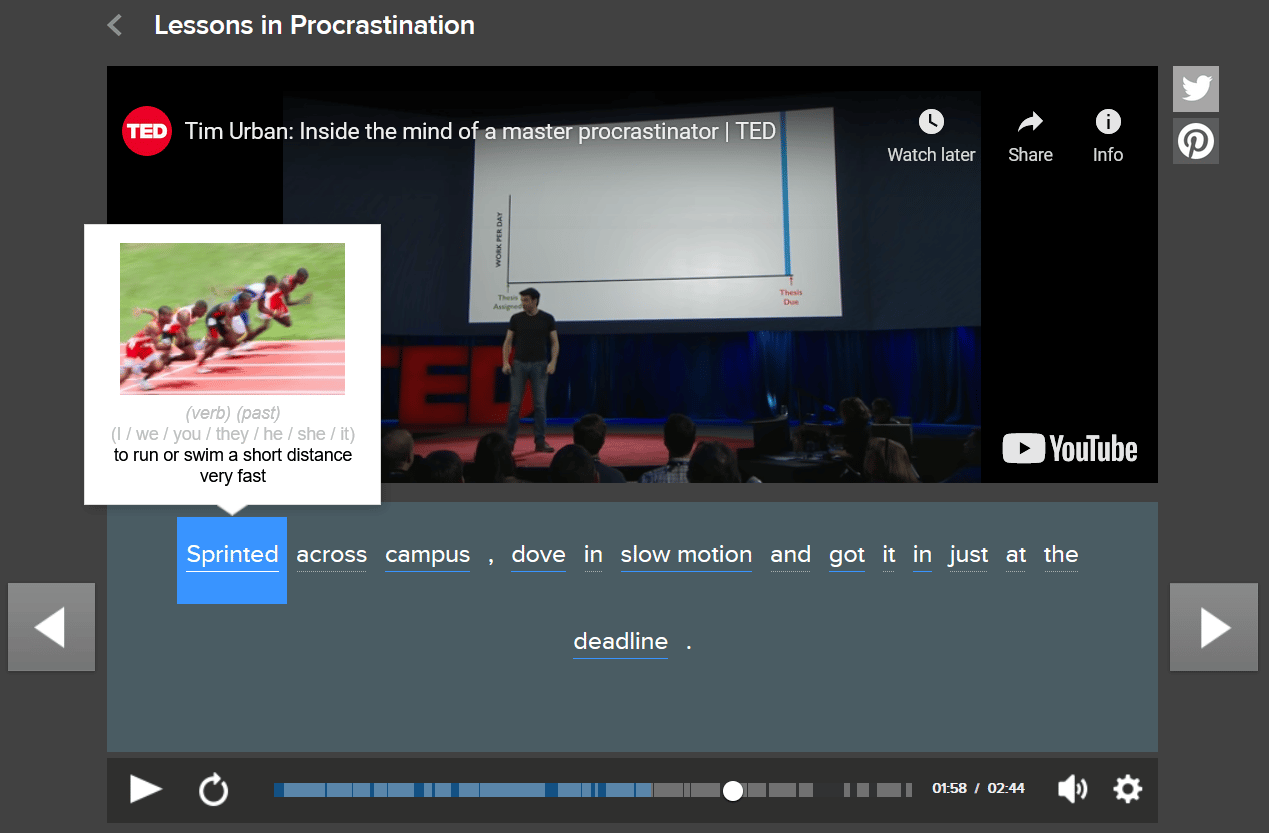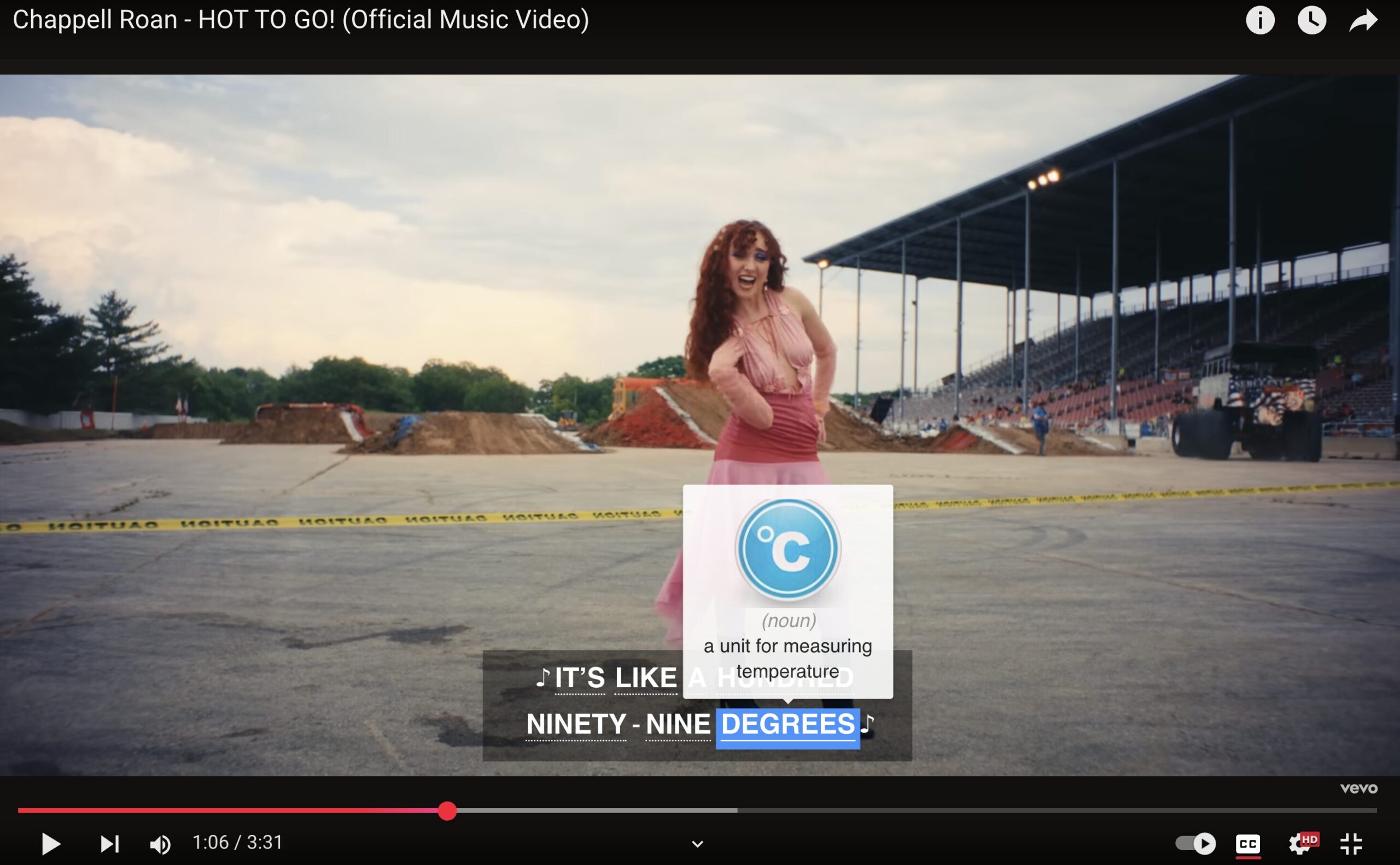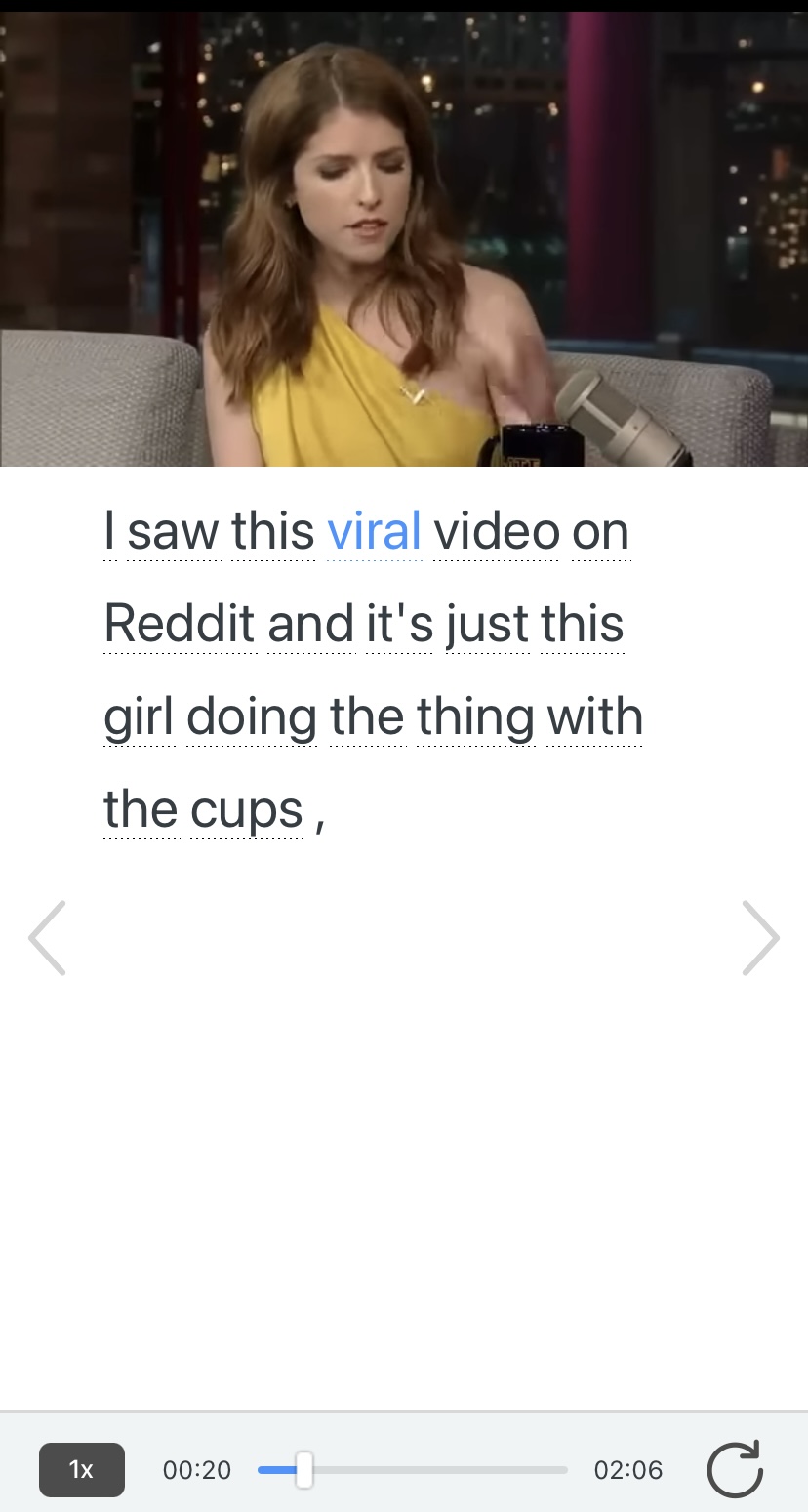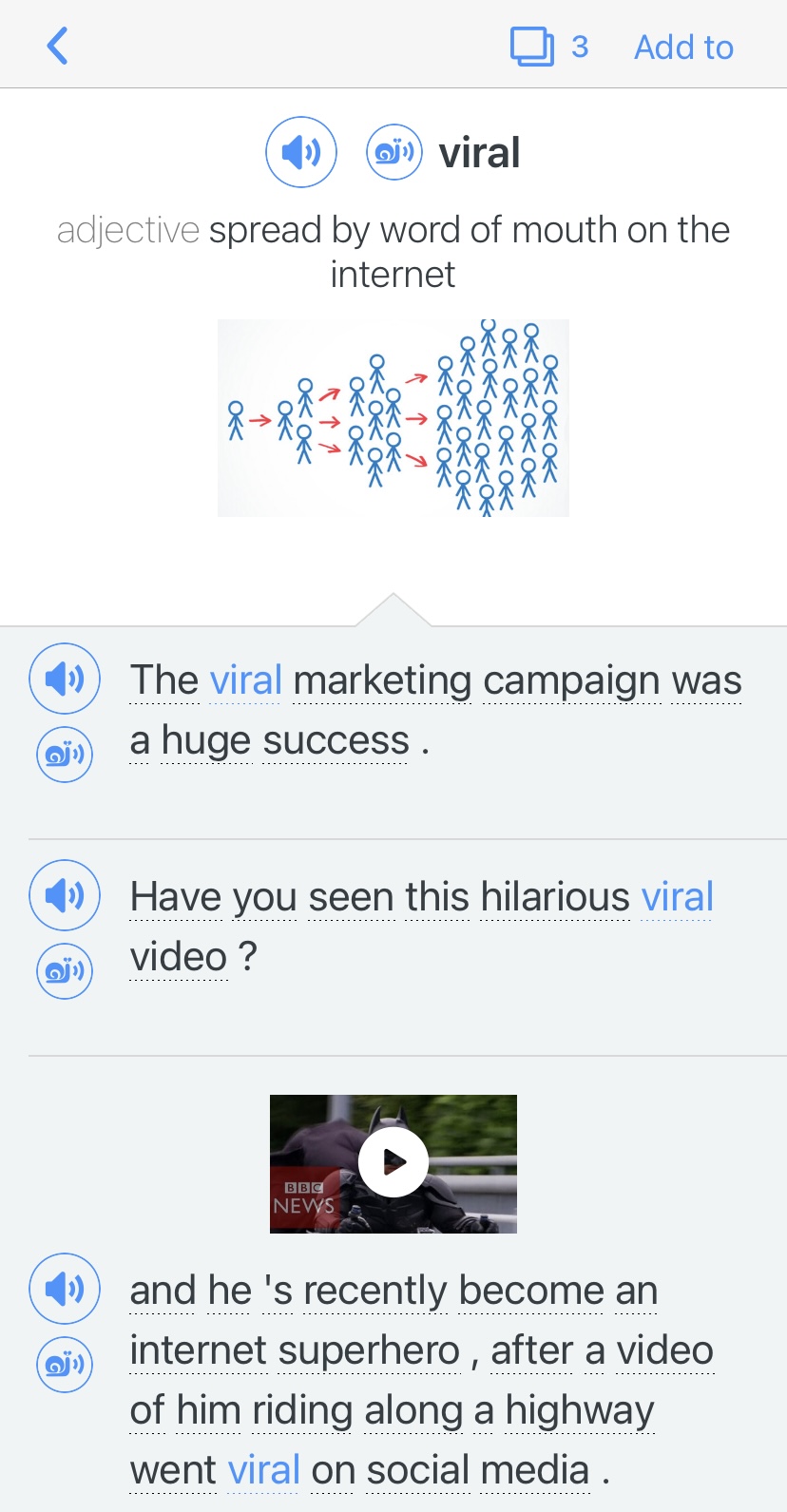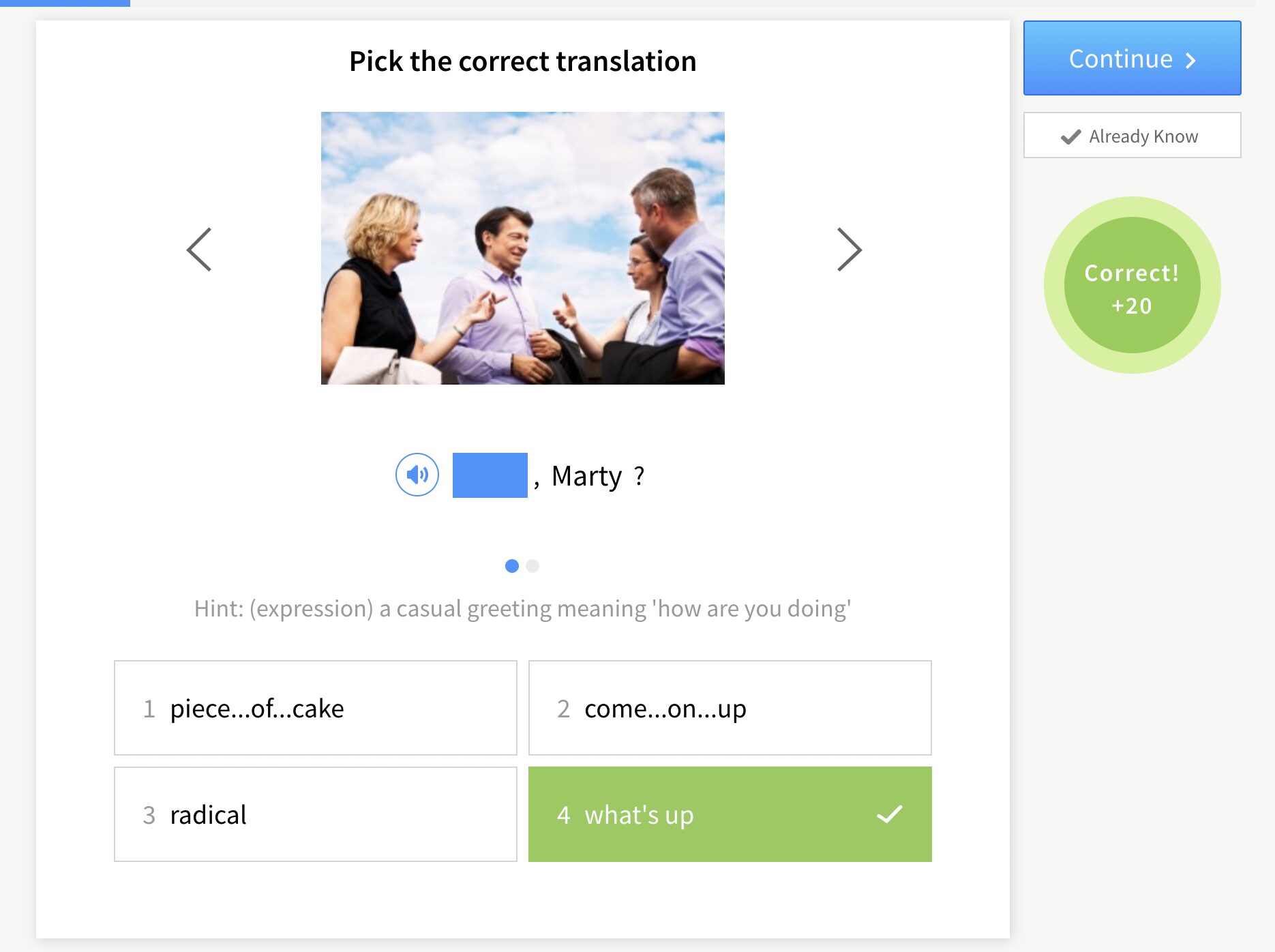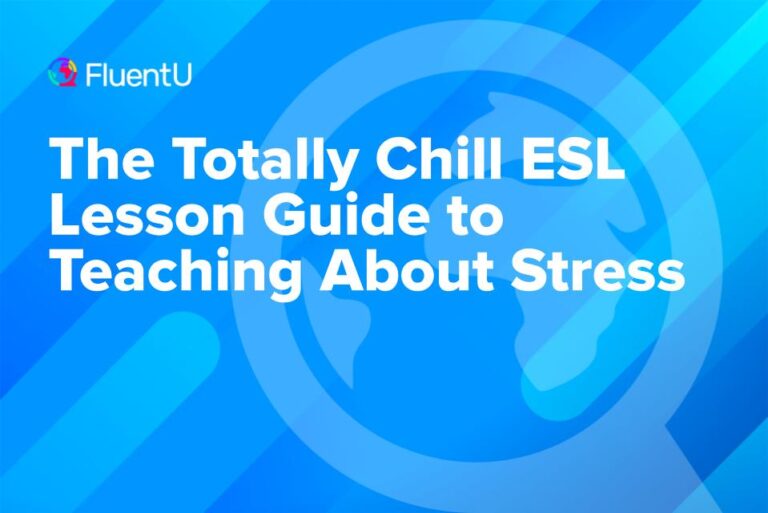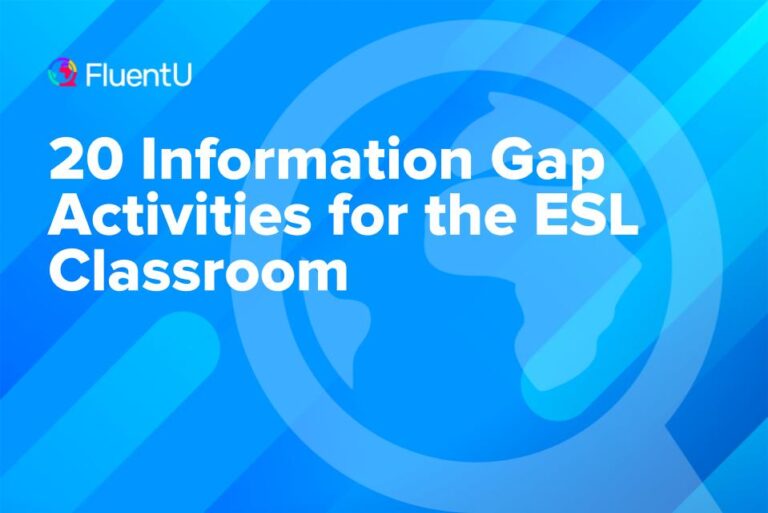Contents
- TED Talks with Activity Ideas
- “4 Reasons to Learn a New Language” by John McWhorter
- “There’s More to Life Than Being Happy” by Emily Esfahani Smith
- “Why Do We Sleep?” by Russell Foster
- “A Tribute to Nurses” by Carolyn Jones
- “Before I Die I Want To…” by Candy Chang
- “10 Ways to Have a Better Conversation” by Celeste Headlee
- “How to Talk so People Want to Listen” by Julian Treasure
- “How Languages Shape the Way We Think” by Lera Boroditsky
- “What Makes a Good Life?” by Robert Waldinger
- “How to Find Work You Love” by Scott Dinsmore
- “Want to Be More Creative? Go for a Walk” by Marily Oppezzo
- “Where Did English Come From?” by Claire Bowern
- “Where Do New Words Come From?” by Marcel Danesi
- “The Myth of Prometheus” by Iseult Gillespie
- More Easy TED Talks for ESL Learners
- “Why I Keep Speaking Up, Even When People Mock My Accent” by Safwat Saleem
- “TED’s Secret to Great Public Speaking” by Chris Anderson
- “Let’s Teach for Mastery — Not Test Scores” by Sal Khan
- “The Nit-picking Glory of The New Yorker’s Comma Queen” by Mary Norris
- “Go Ahead, Make Up New Words!” by Erin McKean
- “Metaphorically Speaking” by James Geary
- “How to Write Descriptively” by Nalo Hopkinson
- “How to Get Better at the Things You Care About” by Eduardo Briceño
- “Why You Should Define Your Fears Instead of Your Goals” by Tim Ferriss
- “What’s a Snollygoster? A Short Lesson in Political Speak” by Mark Forsyth
- “The First 20 Hours — How to Learn Anything” by Josh Kaufman
- “5 Techniques to Speak Any Language” by Sid Efromovich
- “Making Sense of Spelling” by Gina Cooke
- “How to Gain Control of Your Free Time” by Laura Vanderkam
- “Rapid Language Hacking” by Benny Lewis
- How to Use TED Talks for ESL Lessons
- And One More Thing…
29 Easy TED Talks for ESL Students

Every ESL teacher has seen TED talks for English language learners at this point. They’re not only some of the best videos on the internet, but some of the best video resources for ESL classrooms, too.
That’s why you should be using them in your ESL classroom. And, as it turns out, it’s not too hard at all to show these to your students in a meaningful, productive way.
Here are 29 interesting TED Talks for ESL students that you can use as classroom resources.
Download: This blog post is available as a convenient and portable PDF that you can take anywhere. Click here to get a copy. (Download)
TED Talks with Activity Ideas
“4 Reasons to Learn a New Language” by John McWhorter
English is one of the most commonly spoken languages in the world. Why bother learning another language if most people can communicate using just this one?
Plus, instant translation technology could soon render language learning obsolete!
To dispute these ideas, McWorter talks about how languages not only give us insights into their respective cultures, but also shape the way we think.
Activities:
Discuss — Why are you learning English?
A short, five-minute discussion of the question gives a simple introduction to this topic, which all ESL students will be able to relate to.
List — The benefits of learning English
This can be done after watching the video. In small groups or pairs, have your students list the benefits they have gotten, or expect to get, from learning English. How do they think English will change their lives?
Compare — English and other languages
Ask your students how English differs from their first language or any other language they have learned. Then, you can introduce the grammar needed to form comparative sentences, such as:
- English is more difficult than French
- Chinese is spoken by more people than English
Superlatives – What’s the most difficult language in the world?
You can then move on to superlatives. After teaching the grammar, you can turn it into a pop quiz. Have students create superlative questions in groups, then ask the rest of the class. You could branch out from language and make world knowledge questions, like these:
- What’s the biggest country in the world?
- What’s the fastest animal on land?
“There’s More to Life Than Being Happy” by Emily Esfahani Smith
A lot of people say that happiness is the meaning of life, but is that really true? In this video, the speaker argues that we should build more meaningful lives, instead of just happy ones.
Activities:
Discuss – What’s the meaning of life?
Introduce the topic by presenting this question and asking your students to give a one-word answer.
Rank – What’s important to you in life?
Whether it’s money, family, happiness, travel or food, your students will have different ideas about what’s important. Give them a list, and ask them to rank them by number to show what their priorities are. Then, they can compare with a partner.
Write – SMART Goals
After watching the video, revisit students’ priorities from the previous activity. Ask them if the amount of time they spend on each item matches its ranking. Chances are, it doesn’t. You can turn this into a writing activity by asking them to write out some life goals.
Teach them about the SMART model to structure their goals—this is an invaluable lesson to learn for goal-setting and life in general.
“Why Do We Sleep?” by Russell Foster
This video uses excellent visual aids to turn what seems like an arbitrary question into a fascinating subject. This also makes it much easier to understand, giving students something to support their listening.
Activities:
Brainstorm – The purpose of sleep
Start your lesson off by asking your students what they think the purpose of sleep is. After watching the video, they can see if this matches up with what they’ve learned.
Grammar – How long? / How many? / How far?
This is a good opportunity to teach how to make “how” questions, which ESL students often mix up with other types of questions. Your students can then use this grammar to make questions, such as:
- How many hours do you sleep per night?
- How long have you studied here?
- How far is it from here to your house?
“A Tribute to Nurses” by Carolyn Jones
This TED Talk is more personal. It’s one woman’s story of how a nurse changed her life and why nurses are so important to her. She speaks relatively slowly, pausing between sentences to make it easy to listen to.
Activities:
Discuss – Difficult jobs
Before introducing the video, ask your students to have group discussions about which jobs they think are the most difficult and why.
List – Duties and responsibilities
After the video, have students write what they think the responsibilities of a nurse are.
This will test their understanding of the basic verb-noun agreement. Ideally, they should come up with something like the following:
- A nurse takes care of patients.
- Nurses give injections.
From there, they can do the same for the other jobs they spoke about in the first activity.
“Before I Die I Want To…” by Candy Chang
If you’re looking for a short video activity, this is perfect. In only six minutes, your students will hear about the creative way in which one woman got her neighbors to open up about their life goals.
It’s clear, concise and easy to understand.
Activities:
Read – Inspirational stories
Give your students a story about an inspirational figure to read. It could be a biography or someone famous, a story you’ve plucked from the news or anyone you think your class might relate to.
After reading, ask your students to discuss who inspires them and why with a partner.
Write – Bucket lists
Introduce the concept of a bucket list and have students write their own. If there’s time, they can present them at the end of the class.
“10 Ways to Have a Better Conversation” by Celeste Headlee
This talk is about 12 minutes long, which makes it a good option for a short class period. The speaker explores the importance of face-to-face communication and teaches the audience how to excel at speaking.
Every ESL student can benefit from this video.
Activities:
Write – Video review
After watching the video, ask them to write their answers to these questions:
- What does a conversation require?
- How many texts do teenagers send a day?
- What do you think “interpersonal skills” means?
- Should you nod and repeat back what someone says to show you’re listening?
- What are the 10 ways to have a better conversation?
Discuss – Free conversation
After watching the video, ask your students to pick a partner and have a conversation using the tips mentioned by the speaker. They can take turns practicing their listening skills and communication skills.
“How to Talk so People Want to Listen” by Julian Treasure
This is another presentation that’s centered on communication. Here, the speaker focuses on making sure people listen. This speech is just under 10 minutes, making it ideal for a short lesson. It also includes some vocal exercises that could be quite fun for your ESL students!
Activities:
Rank – What not to do when speaking?
After the video, list the “seven deadly” sins of speaking and discuss them as a class. You can then ask to rank each of them and ask for their reasoning.
Discuss – Review and reflect
You can also follow up the video with these questions:
- What are the four “cornerstones” of powerful speaking and what does “HAIL” stand for?
- Do you think it’s possible to wish someone well and judge them at the same time?
- What do you want to improve about your speaking?
List – Why is it important to speak clearly?
Ask your students to do a quick writing exercise listing the reasons why it’s important to be good at speaking. If there’s time, a few students can present them at the end of the class.
“How Languages Shape the Way We Think” by Lera Boroditsky
The video is about 14 minutes long and is a little more scientific. It explores how we speak and communicate and the role language plays in the way we think. This talk is more suitable for higher-level language classes, where you can dive into fun topics like perceptions and stereotypes.
Activities:
Compare – Differences between English and your native language
Put your students into groups, then ask them to share their thoughts on the video, then compare how English differs from their native language.
Here are some questions to guide the discussion:
- Do you agree or disagree that language shapes the way we think? Why?
- What was the most interesting thing you learned from this speech?
- Does everyone in the world count the same way or think of color in the same way?
- Does English have gendered words?
Write – Kuuk Thaayore language
Find a few research papers or articles on the Internet about the Kuuk Thaayorre language and hand them out to your students. As a homework assignment, ask them to find examples in the text showing how their language shaped their way of living and thinking.
“What Makes a Good Life?” by Robert Waldinger
Get your students thinking about living and how to live a healthy and happy life. This video is about 12 minutes and offers advice on how to live your best life. It covers a decade-long study that looked at what makes people happy. Your students are sure to be interested in this topic and the ensuing conversation.
Activities:
Write – What makes you happy?
Start your lesson off with a writing exercise. Have them answer the following questions in their journal entry:
- Do you have a good life?
- What makes you happy?
- What would you change about your life?
- Do you feel like you have a good balance between screen time and people time?
After watching the video, they can see if this matches up with what was mentioned in the talk.
List and Share – Life goals
Have students list their life goals, then ask them to find someone in the classroom who has at least one life goal in common. Let them share their life goals with each other, then have them discuss the two major life goals young adults have, based on the video.
“How to Find Work You Love” by Scott Dinsmore
This 18-minute talk is especially useful for ESL learners who are in high school and university. The speaker tells the audience that it’s okay to do work you love and in fact, it leads to a more fulfilling life.
Activities:
Discuss – What do you like to do?
Start off by asking your students to discuss in a group what they like to do and identify why they enjoy certain activities.
Write – Dream job
Using the framework discussed in the video, ask your students to write a short essay on what their dream job would be. Make sure they list their unique strengths and values that will help them be successful in this dream job.
“Want to Be More Creative? Go for a Walk” by Marily Oppezzo
This is a short five-minute talk that explores the idea of creativity and how to brainstorm more effectively. It may appeal specifically to business English language learners or any students who need to keep their minds sharp and fresh.
Activities:
Brainstorm – What do you do to be more creative?
Start out with a quick discussion asking your students if they are creative and if so, in what way.
From there, you can move on to asking them how they get their creative juices flowing. Write their ideas on the board. After watching the video, compare the findings with the brainstorming session at the beginning of class.
Discuss – Review and reflect
Have the students get into small groups and discuss the following questions:
- How many more creative ideas did the “treadmill group” come up with than the “sitting groups?”
- What are the five tips the speaker recommends for brainstorming?
- Do you think this method of brainstorming would work for you? Would you try it?
“Where Did English Come From?” by Claire Bowern
This is a fascinating video on the origin of English. It’s about five minutes and offers a brief history of the language, which is interesting for ESL learners perpetually confused by English’s inconsistent rules and exceptions.
Activities:
Brainstorm – English words in other languages
Before watching the video, ask the students if their native language uses any English words. Have each student write their words down on the board.
Discuss – Video review
Have a class discussion on the video to test their comprehension. Some questions you can ask are:
- Where did English come from?
- What language family did “Old English” belong to?
- Did the Vikings add any words to English?
Research – What’s your favorite word in English?
Have a quick 5-minute discussion asking your students what is their favorite word in English and why. As a homework assignment, you can ask them to look up the origins of their favorite words and share their findings with the class the next day.
“Where Do New Words Come From?” by Marcel Danesi
This six-minute, animated talk shows how new words are created and how English has adopted words from other languages. It’s a great video to go along with any lessons where you’re trying to relate English to your students’ first languages.
Activities:
Discuss – Video review
Ask a few questions with straightforward answers to test your students’ listening skills.
- How many new words are added to the dictionary every year?
- How many words are currently in use in the English language?
- Approximately how much of the English language has been borrowed from other languages?
- What does the word “obsolete” mean?
Grammar – Create a new word
Have students create a new word and write the definition. Along with the definition, ask them to create at least three different example sentences using different tenses.
This can be an in-class activity or a homework assignment.
“The Myth of Prometheus” by Iseult Gillespie
This presentation is under five minutes and tells the story of Prometheus. It’s filled with short illustrated clips which are ideal for any ESL students interested in English literature.
Activities:
Brainstorm – Myths
Before the video, briefly describe what a myth is with the class. Ask them if they know any myths and write them on the board. These myths can also be potential research projects or homework assignments.
Discuss – Video review
Ask your students these questions to test their listening comprehension:
- What does the name “Prometheus” mean?
- What did Prometheus do to help humans?
- How did Zeus punish Prometheus?
Write – Do you think Prometheus was a trickster or a hero?
As an in-class activity or homework assignment, ask your students to write a short essay to answer this question. The length of the answer can be adjusted according to the students’ learning level.
More Easy TED Talks for ESL Learners
“Why I Keep Speaking Up, Even When People Mock My Accent” by Safwat Saleem
If you want to speak a language well, you need to practice speaking it. But very often, English learners have an accent which is very different from the native speakers. This can be embarrassing for the learners and possibly lead to a decline in practice. Stuck in a circle of perceived shame, a large number of learners are never able to become fluent English speakers.
But why is it shameful if someone speaks with a different accent? Safwat Saleem, a Pakistani-American, asks this precise question in his TED Talk. He shares his own personal journey, and tells us how he realized that being different is not the same as being wrong. If you have ever felt embarrassed about your own accent, this talk will surely inspire you and perhaps give you the confidence to speak up again and again.
“TED’s Secret to Great Public Speaking” by Chris Anderson
People generally think that to be a good public speaker, you need a good voice, theatrical gestures, emotional stories about childhood and perhaps attractive looks.
Chris Anderson, a curator of TED Talks for 15 years, thinks otherwise. According to him, the main component of a public speech is the idea you want to share with the audience you are speaking to. An impressive speech builds one main idea in your head, piece by piece, through words and images. And most importantly, your ideas should be useful to the people who are listening to you.
Very often language learners focus too much on the technical details of their speech and not so much on the content. This talk helps you make connections between the words you use and the ideas you want to convey.
“Let’s Teach for Mastery — Not Test Scores” by Sal Khan
Everyone who has attended school agrees on one thing—that it needs to change. In the name of education, students are put through a process which is not only unpleasant, but perhaps even harmful for learning.
Sal Khan, the founder of Khan Academy, locates the problem in the basic structure of schooling. He asks us to imagine a house. If the foundation of that building is not perfect but only satisfactory, then that building will surely break down someday. Similarly, if the basic skills of some subjects like math or English are only half understood, then the students’ learning will also break down.
Sal thinks that what should be fixed is the need for mastery and not the time to learn a subject. This mindset is not only useful for school students but also for every language learner in the world.
“The Nit-picking Glory of The New Yorker’s Comma Queen” by Mary Norris
Whenever we read an article in a magazine or a newspaper, we are not just reading the hard work of one writer, but also a team of editors who helped the author create his best work. But these editors work in the background, and their work is never recognized.
Marry Noris is a copy editor in one of the world’s best literary magazines—The New Yorker. In this talk, she shares her experience of being “the comma queen” and how she edits the work of the best writers of our age. She takes real examples and talks about the grammatical and stylistic rules she uses to edit the articles she is assigned.
This talk is a very good and also funny way to help advanced English learners understand the art of editing and get to know the standards of grammar followed in literary magazines. Many learners will be surprised when they realize that much of the common English we use in day-to-day conversation is considered incorrect by editors. That is why the title has the word “Nit-picking” in it, since it means finding faults in the little details of someone’s work.
“Go Ahead, Make Up New Words!” by Erin McKean
If you read the history of English, you will realize that it changes very quickly. Many people regularly wonder about how new words enter the language. Very few English speakers actually know that most of the words in English today did not exist hundreds of years ago.
Erin McKean studies words and creates dictionaries. She is one of those people who decides what words mean and how they should be used. Surprisingly, she wants you to come up with new words.
Often English learners think that words are like scientific facts—they do not change. But words are just an agreement between the people who use the language. If many people agree that a word means something in a language, then that becomes a part of the vocabulary.
English learners often feel like outsiders who have to obey the rules of the language or they are committing an embarrassing crime. Obviously, rules are important. But McKean makes us realize that language requires active participation and making up new words should be seen as a fun way to expand a language rather than making it “wrong.”
“Metaphorically Speaking” by James Geary
A metaphor is when we give an object the name of something else in order to make a comparison. For instance, Shakespeare called the world a “stage” and compared the people in the world to actors.
As you can see, a metaphor is not only a way to compare things but also to change how we see them. If Shakespeare said that all the world was a jail, our idea about the world would definitely be more negative than the metaphor of the stage.
James Geary talks about this ability of metaphors to change thinking. He uses simple examples and even psychology to show how we can use them in our daily conversations. English learners will definitely learn how to use words to make an impact on the listeners and improve their speaking skills.
“How to Write Descriptively” by Nalo Hopkinson
People love stories because they like living in different realities. Think about a book you love to read and chances are it makes you feel like you are living in the world it describes.
This TED Talk is about the strategies you can use in your writing to attract readers to your work. It gives examples from real books and practical tips which you can use to make the reader feel what the characters feel.
Keeping these tips in mind can help learners use their words in a more purposeful way. This video also helps us understand why we like certain pieces of writing and what makes them special. We do not realize these things while we read a book since we do not focus on the exact ways in which the words have been used.
For more writing tips, we have this invaluable guide for beginners.
“How to Get Better at the Things You Care About” by Eduardo Briceño
Eduardo Briceño talks about two zones in his talk—the zone of learning and the zone of performance. According to him, we often confuse the two and get no results even after working very hard. The important point here is not how much we work but simply how we work.
The zone of performance is where we do our best. We have mastered most of the skills, so we should not expect a lot of mistakes. The zone of learning is when we work on areas that need improvement. We focus on improving things we are not good at.
So if you are a lawyer, your zone of performance is when you are doing a specific part of your job that you are already really good at (preparing the case). However, perhaps there are components of your job that you still find difficult. Spending some time working on those components would mean you are in the learning zone.
Briceño explains how we should practice differently while we learn and how we should not confuse hard work with learning. Many times we focus too much on performance and that ironically decreases our performance over time since we ignore those things which make us improve.
“Why You Should Define Your Fears Instead of Your Goals” by Tim Ferriss
How many times have you heard the advice that setting goals is the key to success? Most people hear that at least a hundred times in their life.
Tim Ferriss has a very unusual view on success. In this talk, he points out that the things which we fear the most are often the actions we need to take in order to succeed.
He explains a simple but uncomfortable strategy used by him, which he calls as “fear-setting.” Rather than ignoring the things which make us afraid, he asks us to confront them and simply do the things that need to be done. This strategy not only improves a skill but also the person as a whole.
“What’s a Snollygoster? A Short Lesson in Political Speak” by Mark Forsyth
Mark Forsyth’s talk is a wonderful guide to understanding how politicians use language and how you can understand them. According to him, they mainly use language to shape how we see reality.
Almost all of us are familiar with the lies of our politicians, but Forsyth says that it is much more complex than that. He talks about lots of words and their origins like “president” and how they were used to change the way people looked at politicians.
For English learners, this is a feast of words where they can considerably increase their vocabulary in just six minutes.
“The First 20 Hours — How to Learn Anything” by Josh Kaufman
Have you ever thought about learning something, but simply dropped the idea because you thought that you did not have time? Or did you start learning something by reading about it and realized that even after weeks you still can not do anything?
Josh Kaufman went through similar experiences, but luckily he found a solution. Through his research, he discovered that you can learn to do anything in 20 hours if you simply start by practicing it. He wanted to learn a musical instrument and he simply started playing the instrument, while learning about it at the same time.
His advice is a gem for beginners who are just starting out.
“5 Techniques to Speak Any Language” by Sid Efromovich
Efromovich is what is known as a “hyperpolyglot,” which means that he can speak a lot of languages. By the time he became an adult, he could speak four languages and then in the next three years he was able to learn three extra ones.
Based on his experience, he talks about five methods he has picked up to learn any language in the world. The first one is, surprisingly, making mistakes, which he thinks is a very important part of pushing you beyond your native tongue and start speaking the new language.
He has many insightful tips about pronunciation, action and reading that he explains through examples from many languages, including Spanish, Portuguese and of course English.
“Making Sense of Spelling” by Gina Cooke
English spelling is confusing to almost every learner. Many people are not able to understand why similar sounding words are spelled so differently and why different sounding words are spelled similarly.
This TED Talk tries to explain some of the rules of English spelling. Using the metaphor of an onion, Gina Cooke tries to explain how it works. Like the many layers of the vegetable, spelling too is the result of many things such as history, meaning and structure of the word.
In the talk she beautifully explains the various ways spelling functions in the English language by taking the word “one.” Every English learner, no matter the level, should watch it so they know why things are spelled the way they are.
“How to Gain Control of Your Free Time” by Laura Vanderkam
How many times have we thought that we can do a task in one hour while in reality it took us five?
This mistake is made by almost everyone in their daily lives. Laura Vanderkam studies the people who do not make such mistakes and make full use of their time.
According to her, our minds almost always think that we have too many tasks in a week while dramatically underestimating (judging something to be smaller or lower than it really is) the time we need to complete them. Her solution is not to “save” time as many of us do, but to organize our lives in such a way that time “saves itself.”
This mindset will be extremely helpful for English learners, since many of them skip practicing certain skills like reading or speaking in a week. The feeling that there is simply not enough time to practice everything regularly is perhaps the top reason why many language learners fail or give up their training.
“Rapid Language Hacking” by Benny Lewis
Language is about communication. We forget this when we start learning it. We start studying it like mathematics, not knowing that it is really hard to learn a language that way.
The best way to learn English or any other language is through direct use and practice. We learn our first, native language by directly listening to it and communicating through it.
Benny Lewis shares his own journey and how he found out the best way to learn a new language fast. The best advice he gives in his talk is using the common words which are recognized throughout the world, like “Coca-Cola.” In this way, a learner can quickly memorize the word and also start using the language almost immediately.
How to Use TED Talks for ESL Lessons
Practice listening
A TED Talk can be a great ESL listening tool for young students and adult students alike. You have thousands of diverse videos to choose from, so you can find videos that work for all age levels, English skill levels, interests and classroom themes.
You can play them with or without subtitles—since TED Talks most often have precise subtitles to accompany them—or even print-outs of their full transcripts from the official TED website.
Use subtitles wisely
Every video on the TED Talk website comes with subtitles in several languages. While it’s okay to use these subtitles—especially when they’re in English!—they shouldn’t be relied upon.
A good tip is to play the video once without subtitles and check how much they understood, then allow them to watch it again with subtitles to see what else they can pick up.
Encourage understanding of the gist, not every word
It’s best to preface any listening activity by telling your students not to worry about understanding every single word they hear. Instead, encourage them to understand the gist by combining what they can understand with context.
Fuel discussion
The best thing about TED Talks is their interesting subject matter. That means that when you use them in your lessons, you can turn them into debate classes by having students share their thoughts about what they saw and heard.
Either allow organic conversations to take place amongst the whole class, or split students into teams and assign them “sides” of the issue to discuss and defend.
Watch TED Talks with full immersion
TED talks can get difficult, depending on the topic. If you want to provide your students with some additional support, you can use a program like FluentU where they can watch native videos like TED talks, vlogs, movie clips and other authentic content with interactive subtitles.
Students can click on these subtitles at any time they get stuck on a word or phrase. You can also print out complete transcripts for your students or access them online for similar interactive features.
Your students can learn with FluentU videos and complete the accompanying exercises and quizzes. Their progress is recorded and their scores go straight to your dashboard, so you can see how everyone is doing.
It can be hard to get your students energized and excited at times, but with these TED Talks for ESL students, you can inject some motivation into your classes and get your students more motivated to learn English.
Maybe you’ll even end up hosting your very own TED Talk about teaching English someday!
Download: This blog post is available as a convenient and portable PDF that you can take anywhere. Click here to get a copy. (Download)
And One More Thing…
If you’re like me and prefer learning English on your own time, from the comfort of your smart device, I’ve got something you’ll love.
With FluentU’s Chrome Extension, you can turn any YouTube or Netflix video with subtitles into an interactive language lesson. That means you can learn from real-world content, just as native English speakers actually speak.
You can even import your favorite YouTube videos into your FluentU account. If you’re not sure where to start, check out our curated library of videos that are handpicked for beginners and intermediate learners, as you can see here:
FluentU brings native English videos within reach. With interactive captions, you can hover over any word to see an image, definition, and pronunciation.
Just click on the word to see other example sentences and videos where the word is used in different contexts. Plus, you can add it to your flashcards! For example, if I tap on the word "viral," this is what pops up:
Want to make sure you really remember what you've learned? We’ve got you covered. Practice and reinforce the vocab from each video with learn mode. Swipe to see more examples of the word you’re learning, and play mini-games with our dynamic flashcards.
The best part? FluentU tracks everything you’re learning and uses that to create a personalized experience just for you. You’ll get extra practice with tricky words and even be reminded when it’s time to review—so nothing slips through the cracks.
Start using the FluentU website on your computer or tablet or, better yet, download our from the App Store or Google Play.
Click here to take advantage of our current sale! (Expires at the end of this month.)
